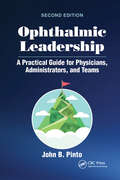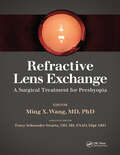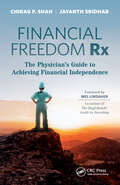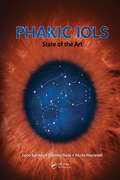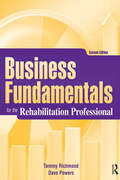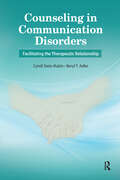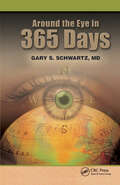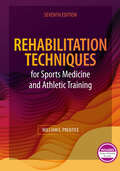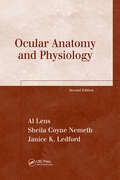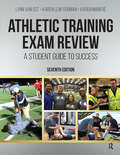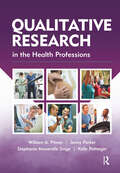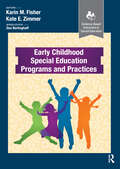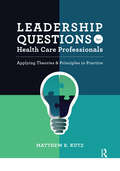- Table View
- List View
Ophthalmic Leadership: A Practical Guide for Physicians, Administrators, and Teams
by John B. PintoOphthalmic practices have many types of leaders, functioning at all levels of the organization. Ophthalmic Leadership: A Practical Guide for Physicians, Administrators, and Teams, Second Edition can provide each of these leaders with the tools to be more decisive, motivating, and effective.John B. Pinto, America’s most published author on the business of ophthalmology, has firsthand experience with the best and worst practice leadership habits from his decades of experience as an ophthalmic practice consultant. He has coached countless physician and lay leaders to the next level of their careers. Together with his team of more than 20 expert contributors, Pinto covers every aspect of leadership in ophthalmology, no matter the size of the practice or the current experience of the team.Chapters include: What Do You Believe in? Developing a List of Core Values for Your Practice Grooming and Moving Line Staff Up to Middle Management Contingency Planning in a Less-Certain Environment Leading Your Team Past the Inevitable Conflicts of Practice Life Everyone in ophthalmology can benefit from the lessons inside Ophthalmic Leadership: A Practical Guide for Physicians, Administrators, and Teams, Second Edition—from the rising ophthalmic technician or department manager, to the managing partner, and even the most seasoned practice administrator.“The book you now hold is a wonderful opportunity to rededicate yourself to your professional development as a leader and to the success of your organization.”From the Foreword by Richard L. Lindstrom, MD
Refractive Lens Exchange: A Surgical Treatment for Presbyopia
by Ming WangPermanent surgical treatment for presbyopia remains the hereto unconquered “last frontier” in anterior segment surgery. Over the years, continuing innovations like Phaco, Radial Keratotomy, LASIK, and premium intraocular lenses have pushed toward this ultimate goal, but now anterior segment surgery is closer than ever with the advent of modern laser-assisted presbyopic lens implantation. Let Refractive Lens Exchange: A Surgical Treatment for Presbyopia, the first book of its kind, be your guide to this fifth wave of innovation in the surgical treatment of presbyopia. Dr. Ming X. Wang, MD, PhD, joined by Associate Editor Dr. Tracy S. Swartz, OD, MS, FAAO and more than 30 expert contributors, compiled this remarkable book. Never before has there been a book dedicated to all aspects of refractive lens exchange as a permanent treatment for presbyopia, both medically and surgically. Highlights of Refractive Lens Exchange include: Overview of all surgical treatments for presbyopia Dysfunctional lens syndrome and pathophysiology Patient education and preoperative assessment Marketing refractive lens exchange as a surgical treatment for presbyopia New technologies in assessing dysfunctional lens syndrome New technologies in mapping cornea and lens for refractive lens exchange Retinal issues related to refractive lens exchange Presbyopic lens types, indications, and contraindications for refractive lens exchange Lens- and cornea-based astigmatism correction Intraocular calculations for post refractive surgery eyes for refractive lens exchange Intraoperative wavefront technology 3D high-definition microsurgical visualization and positioning technology Femtosecond laser application in refractive lens exchange Postoperative care and complication management YAG capsulotomy after refractive lens exchange: indications and alternatives Postoperative care and complication management Keratorefractive enhancement Designed for newcomers as well as seasoned eyecare professionals, Refractive Lens Exchange: A Surgical Treatment for Presbyopia is the first book to guide ophthalmic surgeons, optometrists, and technicians through this exciting new field that is emerging as a safe and effective primary surgical treatment for presbyopia.
Hand Grasps and Manipulation Skills: Clinical Perspective of Development and Function
by Sandra J. Edwards Jenna D. McCoy-Powlen Donna Gallen Michelle A. SuarezHand Grasps and Manipulation Skills: Clinical Perspective of Development and Function, Second Edition is an expertly designed and logically organized text that provides an accurate and clear depiction of the development of hand grasps and the taxonomy of functional hand grasp.Hand Grasps and Manipulation Skills, Second Edition by Sandra J. Edwards, Donna B. Gallen, Jenna D. McCoy-Powlen, and Michelle A. Suarez is full of concise and user-friendly text that is written to assist in understanding complex information. The photographs, illustrations and charts have been expanded in this Second Edition and present new content areas for students and clinicians to use in education and practice.Hand Grasps and Manipulation Skills, Second Edition is unique in that it is also the only text on the market that contains this comprehensive pictorial information about hands and their grasps. Additional unique features include rare information about in utero development of the hand, left handedness, scissor skill development, in hand manipulation skills, and extensive information regarding clinical application. Hand Grasps and Manipulation Skills, Second Edition is a text that can be used as a career long reference. It provides all the pertinent and comprehensive information for students to learn about the development of the hand in one place, and is expertly and thoroughly referenced with the latest research.Hand Grasps and Manipulation Skills: Clinical Perspective of Development and Function, Second Edition provides clear information on a very specific subject, which makes it the ideal reference for occupational therapy professors, students and clinicians; mechanical engineers, computer software instructors, and engineers working in robotics; medical students and orthopedic hand surgeons.
Financial Freedom Rx: The Physician’s Guide to Achieving Financial Independence
by Chirag Shah Jayanth Sridhar"The best physician-specific general financial book published in 2021." —James M. Dahle, MD, author of The White Coat InvestorA step-by-step guidebook for doctors and other medical professionals about growing and preserving wealth, Financial Freedom Rx: The Physician’s Guide to Achieving Financial Independence gives physicians all the tools necessary to manage their own finances and includes a foreword by Mel Lindauer, co-author of The Bogleheads' Guide to Investing. Medical professionals, especially doctors, spend many years in training as they accumulate debt and delay their earnings. This book presents a time-tested formula that students and established professionals can follow at any stage during their careers to achieve fiscal peace of mind. Students will learn how to budget and adopt disciplined financial practices. Residents and other trainees will learn how to defend against calamity with various insurances and how to manage debt. Junior professionals will acquire the skills needed to invest and grow their portfolios, while senior professionals will better understand the essentials of estate planning and retirement. Drs. Chirag P. Shah and Jayanth Sridhar wrote this inspiring text to guide physicians where to put their next dollar. This is particularly important during the financial uncertainties brought on by COVID-19 and insurance cuts. Financial Freedom Rx sets forth principles that will pilot medical professionals toward financial independence. Chapters include useful advice on topics such as: Financial planning Investing and asset allocation Jobs and contracts Taxes and insurance Student loans and debt Retirement savings and distributions Financial Freedom Rx: The Physician’s Guide to Achieving Financial Independence serves as a timeless blueprint for financial planning that medical professionals will follow throughout their careers, and as a reference that readers will revisit again and again as they progress through the various stages of life.
The Little Book of Pediatrics: Infants to Teens and Everything In Between
by Michael Steiner Kelly Smith KimpleThe Little Book of Pediatrics: Infants to Teens and Everything In Between is pocket-sized, easy-to-understand introduction into the field of pediatrics. Written with the non-physician in mind, you will not be bogged down with the heavy details, yet every basic fact that you need is right there.The Little Book of Pediatrics provides a fun and humorous twist to combine the most up-to-date evidence on child health with the practical approach needed for community primary care practices. Written to combine a broad appeal with specific important knowledge on child health, The Little Book of Pediatrics is a conversational-style book that includes images and diagrams that pack a big punch! From head to toe and everything in between—get a quick look into pediatrics: Nutrition Cardiovascular Gastroenterology Dermatology Oral Health Psychosocial Health And More…. Drs. Michael J. Steiner and Kelly S. Kimple also include little known “fun facts” to engage and explain some of the mysteries in children’s health.The Little Book of Pediatrics: Infants to Teens and Everything In Between is an easy-to-read and fun portable resource that will be an invaluable to medical assistants, office staff, students in health sciences, and everyone that works in the pediatrics industry or with pediatric patients, but isn’t a pediatrician.
Phakic IOLs: State of the Art
by Lucio Buratto Stephen Slade Nicola HauraniehThe surgical correction of refractive vision errors has dramatically and continually changed over time. The evolution of laser vision correction has been aided by advancements in the technology, growing experience, and improved understanding of the eye and its response to surgery. However, not all refractive errors can be treated with the laser. Phakic IOLs: State of the Art is designed to provide the advances in phakic IOL technology and techniques, ideal for physicians who treat many of the patients who are not candidates for laser vision correction. The collaboration of Dr. Lucio Buratto, Dr. Stephen G. Slade, and Dr. Nicola D. Hauranieh, along with a team of international surgeons, has produced a complete book specifically aimed to improve the treatment and therefore the quality of vision of patients. Phakic IOLs: State of the Art is designed for ophthalmologists interested in learning the concepts, developing the skills, and preparing for phakic IOL procedures. This book contains a detailed description of the basic technique of the operations, as well as the special techniques devised by the international contributors. Richly illustrated with over 200 images that demonstrate the various concepts, readers are able to develop a more thorough understanding of phakic IOL implantation. This definitive resource couples both the authors’ and contributors’ diverse experience and knowledge to produce a complete resource of vision correction with phakic IOLs.Expert ophthalmologists interested in being on the cutting edge and enhancing their surgical skills, as well as new physicians, will benefit from adding Phakic IOLs: State of the Art to their personal library.
Business Fundamentals for the Rehabilitation Professional
by Tammy Richmond Dave PowersThe world of business is ever changing, with much of the available information becoming quickly out-of-date. Business Fundamentals for the Rehabilitation Professional, Second Edition keeps pace with this changing world and provides the health care professional with the latest information to answer the “what, where, how, and when” questions that come up when transforming a health care practice idea into a successful business.With this updated Second Edition, Tammy Richmond and Dave Powers take the health care professional to the next level of implementing successful business operations by the introduction of applications of management principles, as well as implementation of evidence-based practice guidelines and basics to billing and coding documentation. Business Fundamentals for the Rehabilitation Professional, Second Edition addresses how to identify emerging business opportunities, legal and health care regulatory issues, market research and development, and health care operations.New features in the Second Edition: New Management and Operations checklist An in-depth look at reimbursement, billing, and financial survival Strategic target market promotions Updated templates and tools Review questions Downloadable worksheets available with text purchase Keeping the user-friendly format of a workbook, Business Fundamentals for the Rehabilitation Professional, Second Edition is the perfect resource for master and doctorate level students preparing for the professional world, as well as rehabilitation professionals and entrepreneurs interested in obtaining knowledge in starting up, managing, expanding, or understanding the health care practice system.What will you learn? How to create a vision and mission statement How to develop a business and marketing plan How to manage finances within the scope of the practice What are your local state and federal regulations What are the small business guidelines
Pocket Guide to Intervention in Occupational Therapy
by Kristine Haertl Franklin SteinPocket Guide to Intervention in Occupational Therapy, Second Edition builds upon the strengths of the first edition as a useful quick reference of occupational therapy terms and interventions regarding specific diagnoses and conditions. Occupational therapy is an evidence-based health care profession that uses scientifically based research to justify clinical practice. Interventions in hospitals, clinics, and community and school settings continue to evolve based on scientific evidence. These interventions are intended to prevent injury and maintain or improve client function. Pocket Guide to Intervention in Occupational Therapy, Second Edition by Dr. Franklin Stein and Dr. Kristine Haertl is organized around the major conditions that occupational therapists encounter in their everyday practice. These include physical, psychosocial, cognitive, geriatric, and pediatric diagnoses. Intervention guidelines are outlined for the major disabilities. In addition, there are brief descriptions of the intervention techniques that therapists use and definitions of terms that are relevant to interventions. Intervention techniques encompass the following: Non-medical techniques such as client health education or counseling Instruction in activities of daily living, modifying of environment such as in ergonomics Teaching and demonstrating arts and crafts as therapeutic activities Providing sensory stimulating activities especially for children The appendices include an outline of essential skills for occupational therapists, general developmental guidelines, an overview of muscles and movements, orthotic devices, tables of muscles, average range of motion measurements, prime movers for upper and selected lower extremity motions, and substitutions for muscle contractions.Pocket Guide to Intervention in Occupational Therapy, Second Edition is based on the latest scientific evidence garnered from recent research studies, meta-analyses, scoping reviews, occupational therapy textbooks and their own wide experiences as a clinician, professor and researcher.
Occupational Science for Occupational Therapy
by Doris PierceOccupational Science for Occupational Therapyarticulates how occupational science research produces unique insights into occupation and increases the effectiveness of occupational therapy interventions. This text illustrates the four key types of knowledge now being researched in occupational science: descriptive, relational, predictive, and prescriptive. This text also offers a comprehensive review of occupational science’s history of emergence from the needs and interests of occupational therapy, conflicting origins and intents, and ongoing development as a discipline within academia. In Occupational Science for Occupational Therapy, Dr. Doris Pierce and an outstanding group of occupational scientists explain how their discoveries build the science and support practice. A rich variety of methods and perspectives mark the work of these career scientists as they respond to the knowledge base needs of occupational therapy. This fully evidence-based text also brings the research experience alive for occupational therapy students, describing the passions, challenges, and choices that are the reality of research as an occupation. All research chapters discuss how findings build both science and practice, including learning supports in which students can try out research activities, explore assessment, or develop interventions. Most importantly, Occupational Science for Occupational Therapyprovides new and experienced practitioners a thorough exploration of the latest research in occupation-based practice.Occupational Science for Occupational Therapy synthesizes key works by occupational scientists, including a foreword by Dr. Elizabeth Yerxa, founder of the science. Occupational therapy and occupational science students, practitioners, and faculty will especially appreciate this book’s comprehensive coverage of work by current leaders of research on occupation-based practice.
Counseling in Communication Disorders: Facilitating the Therapeutic Relationship
by Cyndi Stein-Rubin Beryl AdlerIncorporating a counseling paradigm has been shown to increase motivation, deepen learning, and sustain progress for clients and families. Counseling in Communication Disorders: Facilitating the Therapeutic Relationship by Cyndi Stein-Rubin and Beryl T. Adler, is an engaging textbook, written in a genuine and lively tone, so that the reader may easily relate to the material. The text provides a practical vehicle for speech-language pathology students, clinicians, clinical supervisors, and instructors to get to know themselves better and to integrate basic counseling attitudes and tools into their diagnostic and therapeutic programs. Inside Counseling in Communication Disorders, Stein-Rubin and Adler describe the importance of addressing a client’s communication challenges by working with the whole person, as a human being, not as a communication disorder. By approaching clients with a counseling attitude that encourages the client’s full participation in the treatment process, we then work together in partnership and as a powerful team. The content, techniques, and exercises within Counseling in Communication Disorders are rooted in evidence-based practice from a variety of psychological, counseling, and coaching approaches, such as Humanistic Counseling, Listening and Language, Narrative Therapy, The Cognitive Behavioral Model (CBT), Solution-Focused Brief Therapy (SFBT), Positive Psychology, Neurolinguistic Programming (NLP), and Mindfulness training.Counseling in Communication Disorders also includes reflective questions, exercises, and suggestions to reinforce important concepts. To bring the content to life, real-life and clinical scenarios are interspersed throughout the text.It is well understood that speech-language pathology and audiology clinicians must understand deep listening and how to choose words that will have a positive impact on their client and families, but often overlooked is the personal development of the clinicians themselves. Counseling in Communication Disorders is a comprehensive guide on how to provide the necessary support and encouragement to clients and build self-esteem, while a major focus is the need for the clinicians to work on self before working on other. Counseling in Communication Disorders: Facilitating the Therapeutic Relationship is the first textbook of its kind to comprehensively cover both sides of the therapeutic relationship. Students and clinicians alike will appreciate this unique approach that addresses not only the counseling attitude that is vital to the growth and progress of clients, but also the self-awareness that guides the personal development of the clinician.Included with the text are online supplemental materials for faculty use in the classroom.
Documentation Basics for the Physical Therapist Assistant (Core Texts for PTA Education)
by Mia Erickson Rebecca McKnightComplete and accurate documentation is one of the most important skills for a physical therapist assistant to develop and use effectively. The new Third Edition of Documentation Basics for the Physical Therapist Assistant continues the path of teaching the student and clinician documentation from A to Z. Mia Erickson and Rebecca McKnight have updated this Third Edition to reflect changes in the ever-evolving profession. Newly addressed are the changes in documentation requirements for major payers, changes in the disablement models used, and the increasingly common use of electronic documentation in the physical therapy profession. Features inside the Third Edition: Readers are encouraged to think about disablement and disablement concepts when writing notes How to document impairments in body structure and function but more importantly activity limitations and participation restriction Descriptions of the differences in documentation methods using a computer vs paper chart Evidence tied to benefits and challenges of computerized documentation Documenting the rationale for treatment and the unique skills of the physical therapist assistant in patient management New inside the Third Edition: Incorporation of the International Classification of Functioning, Disability, and Health disablement model Chapter on electronic documentation Screenshot examples of the popular WebPT® electronic medical record platform Updated chapters on reimbursement and legal issues Additional examples for student practice included in each chapter Included with the text are online supplemental materials for faculty use in the classroom. Documentation Basics for the Physical Therapist Assistant, Third Edition is the perfect guide for all physical therapist assistant students and clinicians who want to update and refine their knowledge and skills in documentation.
Pediatric Stroke Rehabilitation: An Interprofessional and Collaborative Approach
by Sabrina Smith Heather Atkinson Kim Nixon-CavePediatric Stroke Rehabilitation: An Interprofessional and Collaborative Approach is a groundbreaking text designed to enhance the practice of all health care providers, enrich discussion, and emphasize the interdisciplinary nature of managing best outcomes for a child who has had a stroke. Evidence-based practice is threaded throughout the text with an emphasis on recovery vs. compensation, goal achievement, and outcome measurement.In conjunction with the interdisciplinary contributions from a wide variety of health care professionals, Drs. Heather Atkinson, Kim Nixon-Cave, and Sabrina E. Smith aim to provide the necessary tools to effectively treat children with stroke.The first section reviews the medical fundamentals, covering all major types of strokes. The second section of Pediatric Stroke Rehabilitation focuses on the core of the matter, rehabilitation. The final section expands the understanding of the child’s recovery to the family, community, and school environment.Select chapters include: Personal vignettes written by family members of children who have had a stroke that provides insight into the impact a stroke can have on the child and family A family focus box to summarize the main points of the chapter to provide the best tools for caregivers to advocate for their child A case study related to the content and family perspective Pediatric Stroke Rehabilitation also utilizes the World Health Organization’s International Classification of Functioning, Disability, and Health (ICF) framework throughout.Included with the text are online supplemental materials for faculty use in the classroom.Pediatric Stroke Rehabilitation: An Interprofessional and Collaborative Approach is an interdisciplinary and invaluable resource for students and clinicians to understand and apply effective evidence-based practice and treatment approaches for childhood stroke. The text will also be of interest to healthcare professionals, specifically physical therapists, occupational therapists, speech-language pathologists, physicians, neuropsychologists, nurses, and educators, who work with children who have experienced a stroke.
The Comprehensive Manual of Therapeutic Exercises: Orthopedic and General Conditions
by Elizabeth BryanTherapeutic exercises can be found spread out amongst numerous texts, handouts, card boxes, and websites, which has sent clinicians, practitioners, and trainers searching for reliable, evidence-based exercises for the entire body, all packaged into a single, all-inclusive manual. To that end, The Comprehensive Manual of Therapeutic Exercises: Orthopedic and General Conditions was written as a fundamental resource on exercise theory and techniques, and as a comprehensive guide for designing exercise programs. Dr. Elizabeth Bryan has compiled thousands of clinically relevant exercises to create a text that will teach students theory and proper application that they will then return to again and again in their career as a reference to aid in designing evidence-based exercise programs for their clients or patients. Introductory chapters cover exercise parameters, exercise progression, the importance of form, muscle soreness, and a reference for body position terminology, then subsequent chapters are organized by body area to cover most of the clinical exercises in use today. Each exercise includes photographs, a list of muscle systems that will be affected, specific substitutions to look for, and detailed instructions directed at students and clinicians. Also included are sections devoted to protocols and specialty exercises including yoga and tai chi. Embracing the principles of evidence-based practice, “Where’s the Evidence?” boxes are prominently featured throughout the text to support the exercises and theory with up-to-date, relevant, sufficient, valid, and reliable studies. Combining theory with practice, The Comprehensive Manual of Therapeutic Exercises: Orthopedic and General Conditions is an essential tool for students as well as clinicians, practitioners, or trainers to find the most appropriate exercises for their client’s or patient’s needs and apply them properly.
Around the Eye in 365 Days
by Gary S. SchwartzWhat if there was a book all about the world of ophthalmology? What if there was a book that covers clinical information, history, sports, and the arts—and all are related to eye disease? What if you only needed to spend 10 minutes a day to reap the daily benefits from inside the pages of this unique book?Around the Eye in 365 Days will do all this—one page and one day at a time.Around the Eye in 365 Days by Dr. Gary Schwartz is a quick look into the fascinating world of ophthalmology. It will take you on a daily journey of facts, testimonials, history, surgical techniques, as well as the future path of the profession. Following a daily calendar format, Around the Eye in 365 Days will remind you each day of why you went into the eyecare profession and are a part of this ever evolving industry. The one page a day format plus wide ranging topics, makes Around the Eye in 365 Days a fun and interesting read for all in the field from general ophthalmologists to optometrists to residents to students to office staff to industry sales forces. Wake up each day or retire each night with this daily reminder revolving around the world of ophthalmology. Whether it be a look at the perception of color, Benjamin Franklin, or to refresh and rejuvenate your mind about LASIK—there will 366 turns of the page waiting for you inside Around the Eye in 365 Days. Start your year off today—revisit it often—and take pride in the history and progress that is ophthalmology.
Curbside Consultation in Pediatric Ophthalmology: 49 Clinical Questions (Curbside Consultation in Pediatrics)
by Rudolph WagnerAre you looking for concise, practical answers to those questions that are often left unanswered by traditional pediatric ophthalmology references? Are you seeking brief, evidence-based advice for complicated cases or controversial decisions? Curbside Consultation in Pediatric Ophthalmology: 49 Clinical Questions provides quick answers to the tricky questions most commonly posed during a “curbside consultation” between pediatricians. Dr. Rudolph Wagner has designed this unique reference which offers expert advice, preferences, and opinions on tough clinical questions commonly associated with pediatric ophthalmology. The unique Q&A format provides quick access to current information related to pediatric ophthalmology with the simplicity of a conversation between two colleagues. Numerous images, diagrams, and references allow readers to browse large amounts of information in an expedited fashion. Some of the questions that are answered: • How do I make the diagnosis of amblyopia?• How can I differentiate a true strabismus from a pseudo-strabismus? • How do I diagnose and treat corneal abrasions? Does patching remain an important component of therapy?• What is naso-lacrimal duct obstruction? How is it managed? When should I refer these children? • How can I determine if a “red eye” is caused by a bacterial infection, viral infection or an allergic reaction? How are they managed?Curbside Consultation in Pediatric Ophthalmology: 49 Clinical Questions provides information basic enough for residents while also incorporating expert advice that even high-volume pediatricians will appreciate. Pediatricians, nurse practitioners, emergency room physicians, physician assistants and family practitioners will benefit from the user-friendly, casual format and the expert advice contained within.
Acing the IBD Questions on the GI Board Exam: The Ultimate Crunch-Time Resource
by Brennan Spiegel Hetal KarsanThe world of inflammatory bowel disease (IBD) knowledge is vast. Within that world is a sub-set of knowledge that is especially important for everyday clinical care. And a sub-set of that is testable for the Board exam. The testable material includes time-honored, locked-in-stone, mostly uncontroversial facts that have withstood the test of time. The answer to your study questions (and reduction of your study time!) can be found inside Acing the IBD Questions on the GI Board Exam: The Ultimate Crunch-Time ResourceUntil now, there has been no single, slim, but high-yield volume that summarizes the IBD you really need to know for the board exams, preparing for rounds, or just plain read. The authors have collected every pearl of wisdom, high-yield factlet, IBD "Board buzzword," micrograph, and classic imaging study they could muster, all while keeping Acing the IBD Questions on the GI Board Exam: The Ultimate Crunch-Time Resource a manageable size.In today’s fast-paced world it is hard to keep up with the burgeoning IBD literature. Traditional textbooks usually feature long and detailed discussions that don’t directly address board and recertification exams. On the flip side, many board review manuals provide lists and bullet points lacking sufficient background and context. Acing the IBD Questions on the GI Board Exam by Drs. Brennan Spiegel and Hetal Karsan, fills the unmet need in board review by presenting time-tested and high-yield information in a rational, useful, and contextually appropriate format.Why you need Acing the IBD Questions on the GI Board Exam:• Focuses exclusively on inflammatory bowel disease review• Carefully vetted board-style vignettes with color images• Comprehensive yet succinct answers using a high-yield format• Emphasis on key clinical pearls and “Board Buzzwords”• Rapid-fire crunch time exam with 140 classic one-liners such as:Diarrhea + mucus-filled cysts throughout colon = ?The vastly evolving world of IBD includes genetic breakthroughs and new medications with different risks and benefits. Acing the IBD Questions on the GI Board Exam has it all in one resource that includes endoscopic, histologic, radiologic and dermatologic manifestations, as well as with great images and tables to help guide the reader.Chapters include:• A compilation of general lessons learned from past test takers• “Tough Stuff” board review vignettes• “Crunch-Time” Self-Test—Time to get Your Game On! With its focus on pearl after pearl, emphasis on images, and attention to high-yield “tough stuff” vignettes you don’t know the answers to (yet), Acing the IBD Questions on the GI Board Exam: The Ultimate Crunch-Time Resource will help you ace the GI and recertifying examinations, look good on clerkship rounds, simply challenge you with interesting and entertaining vignettes, and take optimal care of your IBD patients in clinical practice.
Rehabilitation Techniques for Sports Medicine and Athletic Training
by William PrenticeRehabilitation Techniques for Sports Medicine and Athletic Training, Seventh Edition is the definitive reference for athletic training students and professionals who are interested in gaining more in-depth exposure to the theory and practical application of rehabilitation techniques used in a sports medicine environment.Dr. William Prentice and his contributors have combined their knowledge and expertise to produce a single text that encompasses all aspects of sports medicine rehabilitation. Featuring more than 1,000 full-color illustrations, 700 high-resolution videos, and an integrated laboratory manual, this newly updated Seventh Edition provides the athletic trainer with a complete guide to the design, implementation, and supervision of rehabilitation programs for sport-related injuries.The Seventh Edition includes new and updated information on topics including:• Pharmacology and the role of medication in pain management and performance• Nutrition and its impact on rehabilitation• Rehabilitation techniques for the core • Roles within the rehabilitation team• Pathomechanics and epidemiology of common injuries• Psychological considerations and communication with injured patients• Tips for documentation from Dr. Prentice Included with the text are online supplemental materials for faculty use in the classroom.Rehabilitation Techniques for Sports Medicine and Athletic Training, Seventh Editionis a comprehensive resource for athletic training students, faculty, and clinicians; physical therapists who manage rehabilitation programs for sports-related injuries; as well as for strength and conditioning coaches who supervise performance enhancement programs on return to play.
Ocular Anatomy and Physiology (The Basic Bookshelf for Eyecare Professionals)
by Janice K. Ledford Al Lens Sheila Coyne NemethUpdated to include new material for beginners in ophthalmology and optometry, Ocular Anatomy and Physiology, Second Edition is an essential text that covers a range of fundamental information for students and clinicians. With collaborations from Al Lens, Sheila Coyne Nemeth, and Janice K. Ledford, Ocular Anatomy and Physiology, Second Edition now begins with a jump-start chapter to overview the topic for those new to the field of eye care. Chapter two delves into embryology—a topic rarely covered—and addresses each structure of the eye, including the bony orbit, eyebrows, eye lids, lacrimal system, extraocular muscles, and the globe. While the text continues to emphasize normal anatomy, each chapter contains a glossary of common disorders. Also included is a description of diagnostic methods for examining various tissues. The physiology of various structures and systems is explained, including the visual pathway, the inflammatory response, immunology, binocular vision, refractive errors, and accommodation. To enhance the reader’s understanding of each topic, illustrations are provided.Features of the Second Edition: New jump-start chapter for beginners Details on diagnostic methods for each structure or segment, including optical coherence tomography and retinal thickness analysis Glossary of common disorders at the end of each chapter With new features and information, Ocular Anatomy and Physiology, Second Edition is a valuable text for ophthalmic and optometric assistants, training facilities, and practices, as well as beginners in the field of eye care, including sales representatives and pre-med students.
Athletic Training Exam Review: A Student Guide to Success
by Lynn Van Ost Karen Lew Feirman Karen ManfriFor more than 20 years, Athletic Training Exam Review has empowered and enabled students to assess and evaluate their athletic training knowledge, skills, and decision-making abilities. Now, newly updated for its platinum anniversary, the Seventh Edition continues a tradition of excellence while serving as a premier guide to successfully achieving certification as an athletic trainer.The Seventh Edition serves as a comprehensive self-evaluation tool, elevating readers’ level of preparation for the BOC exam. This market-leading guide has made a positive impact on the athletic training profession by highlighting and improving students’ strengths and weaknesses.What’s inside: Updated study techniques and test-taking strategies An expanded overview of the exam format to assist in organization and planning More than 1,300 multiple-choice questions and nearly 100 true/false questions, updated and organized according to the BOC’s Practice Analysis, Seventh Edition Educational Domains Clinical decision-making questions testing the ability to make appropriate judgment calls using problem solving A skills assessment composed of 26 problems designed to test manual athletic training skills Scenario-based problems to strengthen critical-thinking abilities In addition to the updated content, the Seventh Edition also features a fully redesigned and expanded online test-taking experience, including: New user-friendly, mobile format 8 knowledge assessment tests—3 more than the previous edition! 5 unique true/false exams 20 total drag and drop identification photographs—8 more than the previous edition! 43 critical-thinking scenarios 3 clinical decision-making exams containing scenario-based exam questions 13 video segments with related questions for practicing evaluation and assessment Athletic Training Exam Review has assisted thousands of students and has become a hallmark text around the globe. Connecting the classroom with clinical education, this review tool is a timely and critical text that prepares students for their exam and career as an athletic trainer.
The OTA’s Guide to Documentation: Writing SOAP Notes
by Marie MorrealeThe bestselling, newly updated occupational therapy assistant (OTA) textbook, The OTA’s Guide to Documentation: Writing SOAP Notes, Fifth Edition explains the critical skill of documentation while offering multiple opportunities for OTA students to practice documentation through learning activities, worksheets, and bonus videos.The Fifth Edition contains step-by-step instruction on occupational therapy documentation and the legal, ethical, and professional documentation standards required for clinical practice and reimbursement of services. Students and professors alike can expect the same easy-to-read format from previous editions to aid OTAs in learning the purpose and standards of documentation throughout all stages of the occupational therapy process and different areas of clinical practice.Essentials of documentation, reimbursement, and best practice are reflected in the many examples presented throughout the text. Worksheets and learning activities provide the reader with multiple opportunities to practice observation skills and clinical reasoning, learn documentation methods, create occupation-based goals, and develop a repertoire of professional language.Templates are provided to assist beginning OTA students in formatting occupation-based SOAP notes, and the task of documentation is broken down into smaller units to make learning easier. Other formats and methods of recording client care are also explained, such as the use of electronic health records and narrative notes. This text also presents an overview of the initial evaluation process delineating the roles of the OT and OTA and guidelines for implementing appropriate interventions.New in the Fifth Edition: Incorporation of the Occupational Therapy Practice Framework: Domain and Process, Fourth Edition and other updated American Occupational Therapy Association documents Updated information to meet Medicare Part B and other third-party payer requirements Revised clinical terminology on par with current trends Added examples from emerging practice areas Expanded tables along with new worksheets and learning activities Included with the text are online supplemental materials for faculty use in the classroom, this includes: access to supplemental website worksheets, learning activities, and scenario-based videos to practice the documentation process.
Professional Writing in Kinesiology and Sports Medicine
by Mark KnoblauchPublication of a research article can be a defining moment in a researcher’s career. However, the steps involved in turning an initial research question into a published article can be a long and arduous journey. To aid in this process, Professional Writing in Kinesiology and Sports Medicine was developed to serve as a comprehensive writing guide for research professionals and students who are looking to improve their academic writing skills. Dr. Mark Knoblauch and his 15 contributors developed Professional Writing in Kinesiology and Sports Medicine to focus around the area of manuscript development and presentation, while also including chapters that outline the foundational concepts of professional writing, developing a research grant, and the journal selection process. Each chapter is written by content experts who bring a wealth of experience not only from their own academic writing but also from having spent countless hours helping students become better, more effective writers. Many textbooks have been written that focus on development of the research manuscript itself, but what sets Professional Writing in Kinesiology and Sports Medicine apart is that it includes so much more to aid writers in their process.What you can find inside: Examination of ancillary aspects associated with academic research such as poster and oral presentations How to choose the most effective journal How to deal with the stress of writing How to write an effective grant Professional Writing in Kinesiology and Sports Medicine covers those topics and more, with the intent of providing a thorough, practical writing guide that spans the breadth of the research manuscript development, writing, and presentation process. Throughout the textbook, sample writings and cases relevant to the fields of kinesiology and sports medicine are used to provide the reader relevant, applicable examples to help improve their own writing.
Qualitative Research in the Health Professions
by William Pitney Jenny Parker Stephanie Mazerolle Kelly PotteigerQualitative research can provide a great depth of understanding for health professionals in practice. Although many general research texts used in health discipline research courses present a broad spectrum of research methods, their discussion of qualitative methods is often limited. Qualitative Research in the Health Professions by Drs. William A. Pitney, Jenny Parker, Stephanie M. Mazerolle, and Kelly Potteiger, is a practical and straightforward text for those learning about qualitative research in the health professions. In Qualitative Research in the Health Professions, readers will acquire skills in mastering:• Introductory concepts of qualitative research, how it compares to quantitative research, and how to conceptualize a qualitative study • How to conduct a qualitative research study and present findings, including sections on collecting and analyzing data, ensuring trustworthiness of the data, and attending to ethical issues • Advanced concepts including various forms of qualitative research, how to mix quantitative and qualitative methods, and how to evaluate qualitative research Each chapter includes activities and exercises to further students’ understanding and the text also includes personal commentaries from scholarly practitioners in various health professions underscoring the value and importance of qualitative research. Qualitative Research in the Health Professionswill help current and future practitioners master the principles of qualitative research, understand published qualitative studies, and apply these findings in furthering evidence-based practice.
Early Childhood Special Education Programs and Practices (Evidence-Based Instruction in Special Education)
by Karin Fisher Kate ZimmerEarly Childhood Special Education Programs and Practices is a special education textbook that prepares pre- and in-service teachers with the knowledge, skills, and dispositions to deliver evidence-based instruction to promote positive academic and behavioral outcomes for young children (prekindergarten through second grade) with development delays and/or disabilities.Early Childhood Special Education Programs and Practices intertwines inclusive early childhood practices by using real-life anecdotes to illustrate evidence-based practices (EBPs) and procedures. The authors, experts in their fields, emphasize high-leverage practices, EBPs, and culturally sustaining pedagogy and align them with the practices, skills, and competencies recommended by the Council for Exceptional Children’s Division for Early Childhood. Families, administrators, and teacher educators of pre- and in-service early childhood special education and general early childhood education programs alike will find this book useful.Included in Early Childhood Special Education Programs and Practices are: An overview of early childhood and development of children ages 4 to 8 Strategies for relationship building with students, families, communities, and school personnel Tips on creating a caring and positive classroom environment Chapters devoted to evidence-based instruction in core subjects of reading and writing, mathematics, science, and social studies for students with disabilities in pre-K to second grade More than 80 images, photos, tables, graphs, and case studies to illustrate recommended Practices Also included with the text are online supplemental materials for faculty use in the classroom, consisting of an Instructor’s Manual and PowerPoint slides.Created with the needs of early childhood special educators in mind, Early Childhood Special Education Programs and Practices provides pre- and in-service teachers with the skills and practices they need to serve young children, their families, and communities across settings.
Leadership Questions for Health Care Professionals: Applying Theories and Principles to Practice
by Matthew KutzLeadership Questions for Health Care Professionals: Applying Theories and Principles to Practice by Dr. Matthew R. Kutz presents some of the most common leadership questions with the intent to facilitate intrigue and dialogue about the general concept of leadership and an awareness of potential leadership issues facing health care professionals.Leadership Questions for Health Care Professionals presents responses that will initiate discussion, as well as offer solutions based on the best available evidence across a wide spectrum of relevant research. Discussion questions at the end of each response will allow the reader to engage in critical thinking and re-evaluate their experiences and offer new insights into their leadership journey.Sections include questions on key issues for health care professionals: The essence of leadership Leadership development Teamwork and communication Change Organizational culture and complexity Leadership ethics and power Diversity and multicultural leadership Leadership Questions for Health Care Professionals takes an interprofessional and interdisciplinary approach and is relevant for athletic trainers, physical therapists, occupational therapists, speech-language pathologists, nurses, physicians, and more.Leadership Questions for Health Care Professionals: Applying Theories and Principles to Practice offers students a broader conceptual understanding of leadership, as well as the depth required by seasoned health care clinicians, managers, and executives who are looking for practical and evidence-based insights to their toughest leadership issues.
Evaluation and Management of Common Upper Extremity Disorders: A Practical Handbook
by Peter Millett Rachel RohdeEvaluation and Management of Common Upper Extremity Disorders: A Practical Handbook answers the need for a comprehensive, yet concise reference that addresses practical solutions to everyday conditions that general orthopedic surgeons, and specialists alike, as well those involved with general musculoskeletal surgical and nonsurgical care, may encounter.User friendly and pocket size, Evaluation and Management of Common Upper Extremity Disorders by Drs. Rachel S. Rohde and Peter J. Millett provides information on how to diagnose, treat, and manage the most commonly encountered conditions of the upper extremity.Each condition addresses:• Mechanism of injury• Key examination points• Additional testing or imaging• Treatment options (operative and nonoperative)• Surgical anatomy• Surgical procedures• Rehabilitation• Expected outcomes• Potential complicationsJust a few of the conditions covered inside:• Trigger finger and de Quervain’s tenosynovitis• Distal radius fractures• Cubital tunnel syndrome• Distal biceps tendon rupture• Rotator cuff tears• Shoulder instabilityWritten in a bullet format, and including photos for quick, easy reference, Evaluation and Management of Common Upper Extremity Disorders: A Practical Handbook contains valuable information for all levels of training and experience. General orthopedic surgeons, orthopedic surgery residents and fellows, orthopedic surgery physician assistants, nurse practitioners, and nonoperative sports medicine specialists will welcome this thorough evaluation of common upper extremity disorders.
